Gaggia Classic Pro Review (aka New Classic or Classic 2018/2019)
Comments: 47↓ specifications & manual ↓
The most iconic semi-professional espresso machine for home – Gaggia Classic – was updated on the edge of 2018 and 2019. The new version is commonly called Gaggia Classic 2018 or Classic 2019. However, the more correct name is Gaggia New Classic in Europe and Gaggia Classic Pro in the States and Canada. The machine is the same, just voltage differs (220V/120V).
I write this review with two assumptions in mind. First of all, I will try to compare new Classic Pro with cheaper ($100-300) semi-automatic machines, not with more expensive semi-professional equipment. In other words, I will try to answer questions like:
- what to expect when upgrading from, let’s say, Delonghi Dedica or Gaggia Viva to Classic?
- should you buy Classic as a first espresso maker or a present?
- why it makes no sense to buy Classic if you don’t plan to put at least $300/€150 on the grinder
Secondly, this is at least 3rd generation of Classic, and I don’t want to dig deep into a comparison of the current generation with previous ones. Except for the following buying advice, which is important to give:
1. Make sure you are about to buy the right version of Classic
Gaggia Classic Pro (120V version for North America) has a model number RI9380/46. Gaggia New Classic (220V model for the rest of the world) has numerical code RI9480/11 (barcode 886948011010). These are the only designations of updated Classic. Don’t confuse it with the previous generation, which is still in stock:
The most noticeable visual attribute of the older version is black plastic panarello wand vs professional metal steam wand (steamer) of the New Classic.
1. 1. What would be different in the cheaper and older model (14101 vs RI9380)?
On the American market there are not much functional difference between. The new RI9380/46 is better than old Classic 14101 at following:
- The pump is better vibroisolated on the new version. Demitasse will dance less on the cup stand 😉
- The above-mentioned professional metal steam wand with two holes. Old version had a plastic panarello wand, which is easier to use for a beginner, but it gives more bubbles in frothed milk – read here more about the difference.
- New one is made in Italy, old one – in Romania. And that’s the main factor of price rise. Other changes like rubber handles on the hot tubes are minor.
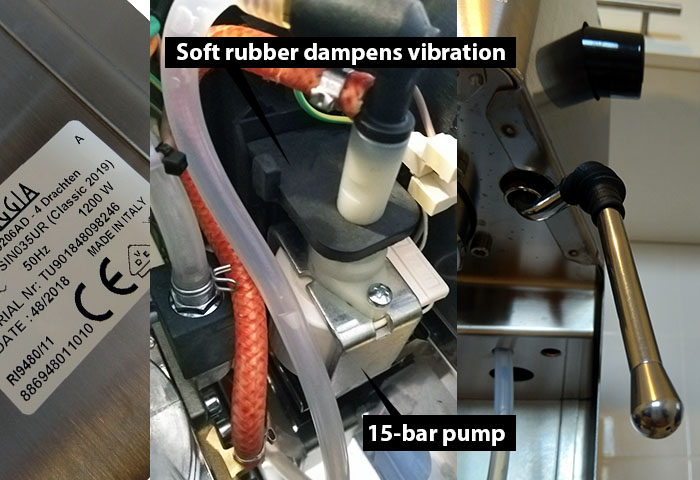
Can’t say anything bad about Romanian assembly, by the way. So if older Gaggia Classic 14101 is currently cheaper and if you are short on budget and don’t need a pro steam wand for cafe-quality milk foam for your cappuccinos and flat whites, then it’s OK to go with it.
NB! The completely different situation on the Europan market. The old European generation (RI9403/11) had much more limited functionality and here we have more differences in addition to the previous list:
- Old european versions had a simple mushroom-valve, not a solenoid valve – what is it and why it is important?
- Plastic coffee spouts in the old model.
- Only pressurized filter baskets come with the old model (in most of the countries, but sometimes Gaggia or local dealers changed the package)
- On the other hand, RI9403 had a bigger stainless steel boiler, while all the new models have smaller aluminium ones.
The old one was a very controversial model. Overall, I would personally prefer to pay more for the New Classic RI9480. Even considering the price gap (below are Amazon.co.uk price comparison):
Reviewing the pros and the cons of this machine, I will start by giving the list of drawbacks. Yes, the machine is not ideal, however, none of the following cons are critical. I list them to prevent the over-expectation effect right away.
2. Cons: No One Cares About The Ease Of Use
Just admit it. The Italian company is focused on the espresso quality in your cup, worried a bit about the design, but don’t give a damn about your everyday comfort. This is common to all semi-professional machines.
- Gaggia claims in its official specifications that the maximum cup height is 3.25 inches (8.25 cm). Bullshit, my ruler clearly shows that it’s 2.75 inches (7 cm) under the coffee pouring spouts and even smallest cappuccino cups like these (amazon link) won’t fit.
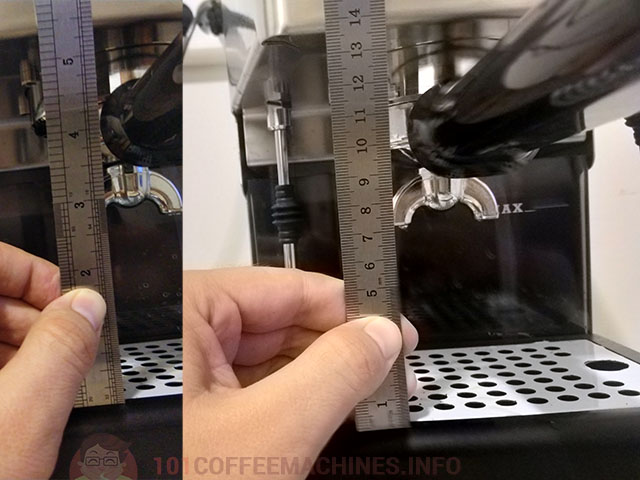
- Guys from Gaggia probably measured the height without spouts, which you can’t unscrew out of the holder, by the way. At least, I didn’t managed to. Even though it’s drawn as a separate part on the diagram. I wanted to do a change for a 1-way spout because my espresso cups are to narrow for original 2-way spouts. It’s 2+ inches (5+ cm) between two coffee flows, another thing you should consider if making one espresso, not two.
- Rocker switches often didn’t really switches from the first touch and the corresponding lights are too dim to be visible on a sunny day.
- The water tank, which is located so much deep into the machine and partly covered by the drip tray, that you can’t see the water level. At least, they made a bypass to add the water from the top without ejecting the reservoir:
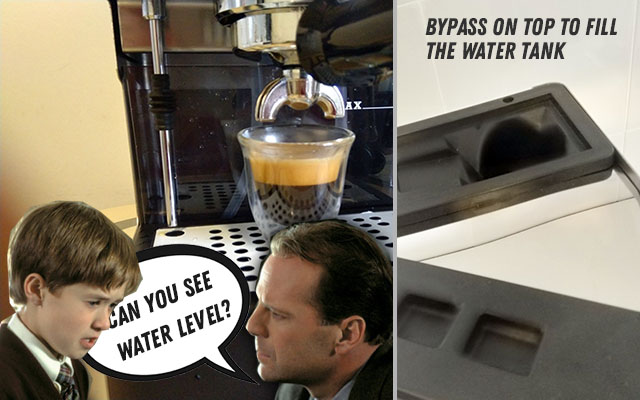
There is approx. 700 ml (22.3 fl oz) of water in the invisible area.
- The water tank max level is 2 litres (68 fl oz, not 72 like is written on Gaggia USA web site), by the way. I personally prefer to keep as less water as possible in my espresso machine because I want water for my espresso to be fresh, and you don’t need much water for several espresso shots. Okay, the bigger water tank is OK, but in my home kitchen, I would rather prefer a smaller machine with smaller water reservoir.
- Finally, yes, the body is huge. Unexpectedly huge, if you get used to home models like Delonghi or if you browse photos on the web. And that’s not because they use the biggest boiler or other parts are too big. No, a small kitty could leave inside Gaggia Classic:
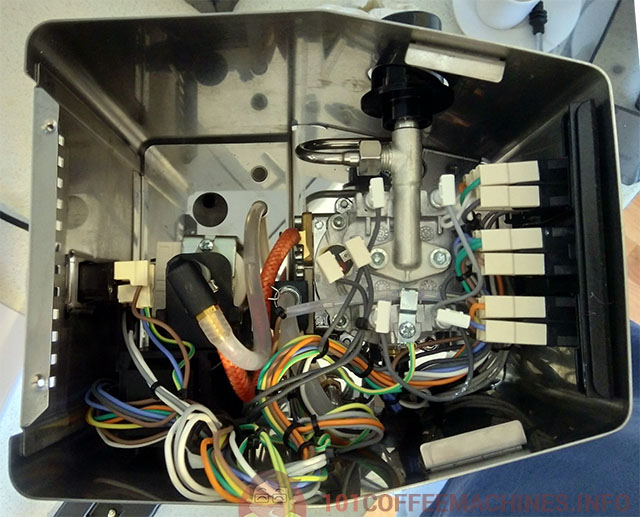
Should I note, that there is no auto dosage or energy-saving functions? Thank God, they made a power button on the front, not on the back, like they used to.
In other words, if we compare Gaggia Classic Pro and the Delonghi Dedica with a similar price tag, then Gaggia gets 1 out of 5 for usability. While Delonghi gets it’s 5/5. But if you are not afraid of these issues, then Gaggia will beat Delonghi in terms of coffee. For sure.
3. Pros: Better Espresso Than On Any Entry-Level Machine
The cons list above may look long and I didn’t even write all the small things that could be improved. But it’s only to illustrate the fact that it’s useless to compare Gaggia Classic Pro/New Classic with any entry-level espresso machines: all Delonghis, including new professionally-looking La Specialista, Gaggia Viva, Saeco Poemia, all machines by Krups, Mr. Coffee, Oster, Hamilton Beach, etc. Gaggia plays in different league, which is characterized by following pros:
- Big brass group head (chrome-plated) → don’t let the temperature in the filter fall during the brewing
- 58mm brass portafilter → professional size allows you to use the finest ground and distribute water evenly through the coffee puck
- Boiler (here we have an aluminium one, unfortunately – they wanted it to heat fast, that’s why). In contradistinction to thermoblock (like on Delonghi EC9335M for example), it also helps to improve the thermostability.
- Unpressurized filter baskets ( = single-wall baskets), of course. They are useless without a grinder and a good tamping technique. However, with such filters, the physics of brewing is the same as in professional espresso machines in Italian coffee shops (while pressurized baskets create artificial resistance, which imitates the resistance that well-tamped coffee should create).
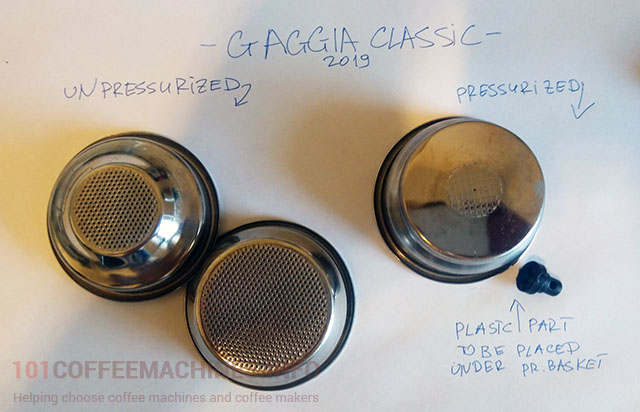
The 1-cup unpressurized filter basket is semi-conical, which is useful because it’s always harder to tamp well the smaller baskets.
These 4 points may sound not so important if we talk about in-home espresso machine. But the fact is that they are. All these results in one, the only, and the strongest feature of new Gaggia Classic 2018/2019.
Under certain circumstances, Gaggia Classic Pro can make you an espresso shot as good as in 9 out 10 specialty coffee shops in your town. Simpler $300 espresso machines with all their bells and whistles can do a decent espresso shot, indeed. But it would be better than in most of the non-Italian restaurants or ordinary cafes. See the difference?
These circumstances are: good freshly ground coffee beans, the machine well heated and well maintained, a little practice and… here we come to the most important… the grinder. The burr grinder.
3. A Good Grinder Is A Must
You’ll need a $300/€150 grinder and it’s not just a coffee geeks mantra. I’ll prove it below.
So, unless you have a coffee shop in the next building, which can sell you every morning a small dosage of freshly ground coffee, you will need a good burr coffee grinder.
- No, not fake flat burr grinder like popular KRUPS-GX5000 or Secura. Did you read my article about coffee grinder types, where I compare microscopic photos of the coffee powder, by the way?
- No, not the cheapest conical burr grinders like OXO Brew, Baratza Encore, Delonghi KG 521 America or Solis Scala. The finest grind level they give isn’t fine enough for a 58-mm unpressurized basket. Yes, as I wrote in my entry-level espresso machines reviews, these grinders are very good for pressurized baskets, but they are incapable to produce grind fine enough for unpressurized baskets.
You may try to buy some of above-mentioned models (they all have identical grinding unit inside) and try to pull the burrs together to achieve finer results (there are a lot of video tutorials of different mods on youtube – example). But even modified grinders of such type would be barely suitable for a 2-cup filter basket. Modified versions are OK for unpressurized 51mm filters, but 58-mm diameter requires even finer grind. Here is why:

The same volume (weight) of the ground coffee in the 51mm and 58mm filter basket. The latter one formes more thin coffee puck. Thus, you need to have a finer grind to create needed resistance to the water flow.
What you need is a coffee grinder of a higher class. I will name few models both for American and European markets that can make a decent setup with a Gaggia Pro/New Classic.
- The cheapest suitable options: Gaggia MDF, Ascaso I-2 or imini I-2, Nemox Lux, Lelit Fred, Isomac IS120044, Demoka GR-0203.
- Better choose following models if you can afford: Ascaso I-1 or imini I-1, Nuova Simonelli MCF or Grinta, Eureka Mignon, Baratza Sette, Rancilio Rocky.
And here is a video proof that I promised. It shows how differently Gaggia Classic behaves depending on the coffee grinder you use:
3.1. What about a pressurized basket that comes with Gaggia Classic Pro/New Classic?
Indeed, they put one pressurized 2-cup filter baskets in the box. But the problem is that it works worse than pressurized baskets on cheaper machines. Delonghi, Saeco and even numerous OEM-manufactured Chinese espresso makers achieved better results in term of pressurized baskets.
If you choose Gaggia Classic with an idea in mind, that you will start with a pressurized basket, and then maybe switch to unpressurized, then.., just don’t think so.
Because without a grinder you will get better espresso on your old cheaper Delonghi/Saeco/whatever than on this machine using a pressurized basket. Paradox, but Gaggia Classic literally force you to immediately get an expensive grinder. It will not get you a good espresso without it. On the other hand, in a pair with a good grinder, you will quickly forget your old Delonghi/Saeco/whatever. As well as the road to your nearest coffee shop 🙂
Another weak side of using the Classic Pro/Classic 2019 with double-wall baskets is the fact that the above-mentioned solenoid valve will suffer from ground coffee (pressurized baskets create backpressure, which pushes coffee powder back to the shower screen and that valve).
Just an illustration of my thesis. Today, when I am writing this review, there is only one negative review on amazon.com about new Gaggia Pro (among six – the machine was introduced in the US not long ago). It’s from a woman who complains about “not good espresso”. She was told that her grinder is no good, so she bought a “burr grinder”, but it didn’t improved her opinion and her espresso. Guess which grinder she bought? 🙂
4. Disassembling and Construction Scheme
Gaggia Pro/New Classic has not the smartest construction scheme. As I already noticed, one may fit all the same parts in the smaller body with less usability issues. On the other hand, this simple and reliable scheme has almost no weak points in terms of durability.
Gaggia Classic is good not because it has some special features or know-hows. It’s good because it uses the classic (tautology!) construction scheme of professional espresso machine for bars and restaurants. Still with some simplifications, of course – there is no PID or adjustable OPV valve, for example. But the Classic 2019 has much fewer compromises than cheap home models.
So, let’s investigate the internals. We have a big stainless steel frame. The upper cover, which also plays the role of a cup warmer/cup stand, is fixed with two tapping screws:
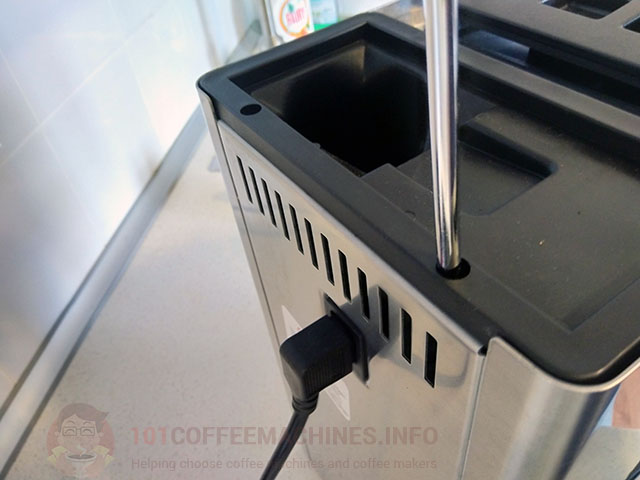
The warmer itself is of a passive type, which means that it becomes hot simply by the heat of the boiler underneath. Here, on Gaggia Classic Pro Semi-Automatic Espresso Machine, a passive cup warmer is quite efficient, because the boiler has external heating elements.
The shape of the boiler – tall cylinder – is one of the reasons why this espresso machine is so big in terms of height. However, the tallness does matter – it affects the steam quality. Output for the steam (all the tubes and fittings for steam are made of metal by the way) is located on top. So when you rotate the steam knob, you don’t wait long for water drops to disappear – after 1-2 seconds you will have completely dry steam. The external heating also helps to achieve this, by the way.
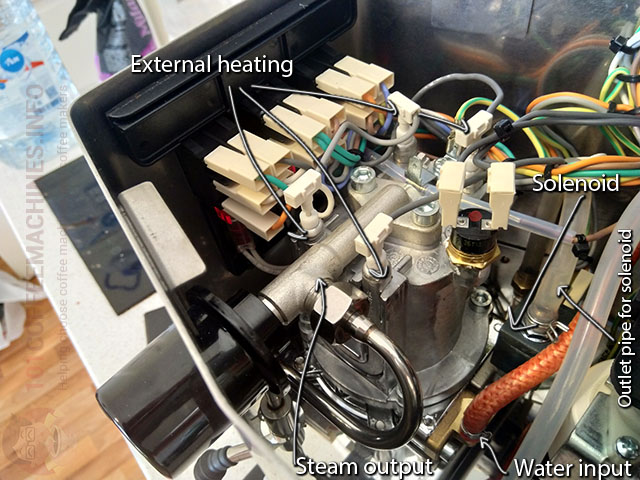
The wires connected to the cup stand on the photo below is just a ground connection. Two bypasses are made weirdly but do their job. The bypass for water tank allows you to fill the water without ejecting the water tank itself. The second bypass (outlet pipe) is connected to the 3-way solenoid valve and flushes the water to the drip tray after you switch off the pump.
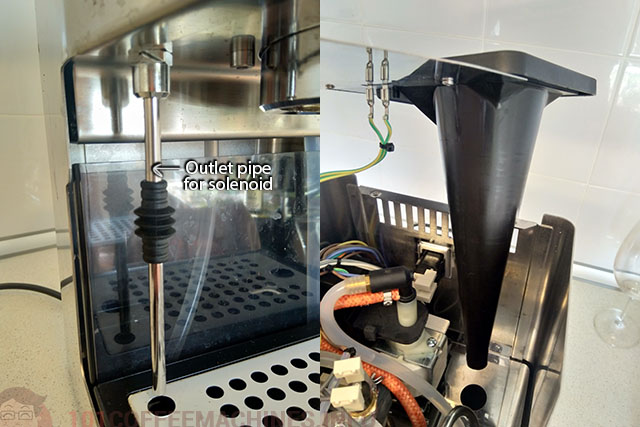
I already noticed solenoid above and promised to explain the difference between simple mushroom-valve that is used in cheaper machines and a solenoid:
- Both valves are used to keep the water inside the boiler. You don’t need it pouring out when the espresso maker is idle, right?
- Mushroom valve (on the photo) is just a spring and plastic knob. When the pump is working, the pressure is high, so the spring shrinks and lets the water out. When one switches the pump off the spring bounces back to its original state and closes the water output.
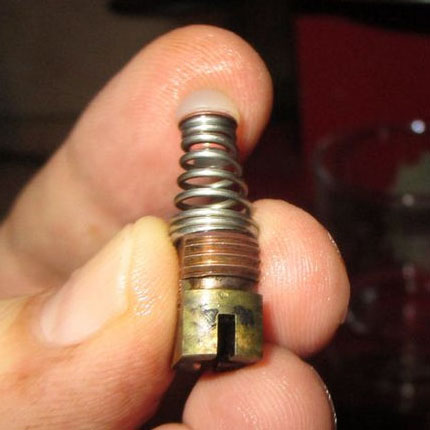
- The problem is that it doesn’t happen immediately. The pressure is rising and falling gradually.
- That’s why when you switch off the coffee button on the espresso machinу with a mushroom-valve, the water continues to flow into the filter basket for 1-20 seconds, which results in water coffee puck and small coffee drops that continue to fall on the drip tray after your already finished with your espresso.
- The 3-way solenoid valve helps to reduce both problems. It immediately flushes unnecessary out of the group, leaving the coffee puck dry, which is useful because it will pop out if you knock. It also helps to clean the group head and the holder. Especially when you are making several coffees in a row.
I can’t say that solenoid is a must, but it’s quite a useful feature.
4. Build quality (pros and cons)
Overall the new Gaggia Classic 2019 is robustly made:
- heavy frame made of brush stainless steel
- reliable water connectors – less plastic tubes, more metal fittings
- minimum of electronics
- edges of the metal parts are well-finished
- a small amount of plastic parts doesn’t have any smells. In case you are worried about plastic, these parts are:
- the water tank
- the above-mentioned bypass to the water tank, which allows to fill it from top
- few tubes from the tank to the boiler (where the water is still cold)
- the small knob inside the portafilter that should be installed only with a pressurized basket.
- that’s all if I didn’t miss anything.
However, there is a feeling that the machine is made a bit offhandedly, without much attention to details and a customer. Just a few examples to add:
- The upper cup plate is fixed with two screws only which aren’t enough to get it fixed well. When you push it with a finger it easily goes down, leaving slights gaps around the edges. I wouldn’t use wet cups here since there are wires underneath.
- These wires, by the way, is fixed to the metal with a sticky material, which weakens after many cycles of heating up and cooling down.
- And yes, the body itself is getting very hot, so be careful.
- The drip tray, which is big enough, isn’t fixed well in its position and plays a little.
- Finally, the rubber legs on the bottom are not fixed very well considering the weight (7 kg = 15 lb with empty water reservoirs) of the machine. Mine often loose its rear left leg when I move it on the glass surface.
5. Conclusion
It’s impossible to review the Gaggia Pro (= Gaggia RI9480 in Europe) without considering the grinder, which is used in pair, and your past experience.
If you upgrading from a budget 15-bar espresso maker (any Delonghi/Saeco/Mr. Coffee/Oster/Hamilton Beach/ anything under the $300 mark), then:
- Expect some problems with ease of use if compared to your old espresso maker.
- Expect worse (surprise!) espresso quality if you don’t get a >$300 grinder and Gaggia’s pressurized basket won’t help.
- Expect espresso and especially milk foam for cappuccino/latte macchiato/flat white to be as in the bar, if you will get the grinder.
- Expect to start clearly feel all these “…smooth notes of red berries and dark chocolate…”, which specialty coffee producers promise.
By the way, some of the coffee grounds that were too acidic on your old machine due to under extraction, on Gaggia Classic will have more balanced body with a bit more bitterness. And hotter.
If you plan to buy it as your first semi-automatic espresso machine:
- Think twice, if you are ready to put approx. $800 for your setup, including a grinder and all the accessories like tamper (the one which comes with the machine is a rubbish), pitcher etc.
- Go with it if you are ready because Gaggia Pro/Classic 2019 is the best machine under $500 (in terms of Recommended Sale Price, of course, on sales or among used machines there could be better options).
- If unsure there are plenty of cheaper machines that make decent home espresso with less hassle. Check my list of best espresso machines for home under $300. You will be able to upgrade when you understand what you really want from your home machine.
If you want the same espresso quality as in Classic but with fewer usability issues or with more functions (mainly PID, which Gaggia doesn’t have), then check the following machines (they are more pricey):
I NEED your opinion. Please rate my review:
Gaggia Classic RI9380/46, RI9480/11 (2019 model) Coffee Machine Specifications: |
|
|---|---|
| Download manual: | Download pdf manual |
| Machine type: | Pump espresso machine |
| Width х Deep х Height: | 20 x 26 x 36 cm (8 x 10.2 x 14.2 inches) |
| Coffee used: | Ground coffee or E. S. E. pods |
| Grinder: | is a must :) |
| Brewing group: | 58mm, chrome-plated brass with pressurized and unpressurized filters |
| Heater: | Boiler 1425 W |
| Max pressure: | 15 bar |
| Water container: | 2 litres (68 fl oz) |
| Cappuccinatore: | Professional steam wand (steamer) |
| Max cup height: | 7 cm (2.75 inches) |
| Controlling: | Rocker switches |
| Peculiar properties: | 3-way solenoid valve |

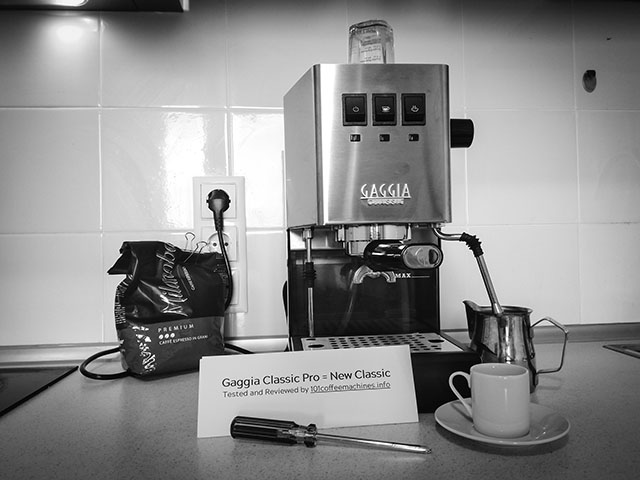



Thanks you for this detailed review. Do you know how big is a boiler of the new classic? I mean its capacity in ml.
Leo
1 Sep 19 at 9:43 am
Hi, Leo! I didn’t measured it precisely this time. But it seems that unofficial information about 140ml boiler is correct, because external dimensions of the cylinder are approx. 5 cm in diameter and 7 cm in height, which give us the volume ~135-140ml.
Dmitriy
1 Sep 19 at 11:20 am
Dear Leo,
At the end of this review you sound like you will list other options to buy, easier to use, but I don’t see your list?
I’m looking to upgrade from the Dedica, which doesn’t make hot espresso, and which clogs all the time.
Thanks!
John
John Lovejoy
24 Sep 19 at 7:38 am
Thanks for feedback, John.
Not only Gaggia Classic “is not so easy to use if compared to Dedica”. It’s characteristic of all machines, that are a bit more professional. Rancilio Silvia, La Pavoni – same issues. Just Ascaso Basic/Arc/Dream https://amzn.to/2mLXkv1 is made a bit better in terms of ease of use.
The better user experience will be on $1000++ machines like Oscar II https://amzn.to/2mhjk0w
In other words, if you want better espresso below $1000 then you should admit some usability issues of semiprofessional units. If you just want better home machine, then maybe some Breville units will be the good choice?
Dmitriy
24 Sep 19 at 8:23 am
That’s probably because you have some adblock software enabled on your computer while Dimitry used an Amazon widget there to list his picks. There are two machines listed there: “Ascaso Dream UP V3 Programmable Espresso Machine w/PID Controller – Dark Black” and “Rancilio Silvia Espresso Machine with Iron Frame and Stainless Steel Side Panels, 11.4 by 13.4-Inch”.
Sajor
14 Oct 19 at 10:08 pm
Hi,
I have a question regardign the 2019 model. The OPV is no longer adjustable compared to the 2015 model. Does the unajustable pressure cause any issues with unpreassurized baskets?
Dave
1 Oct 19 at 10:51 am
Hi, Dave. Thanks for the question, because I didn’t covered this OPV issue in the review.
Indeed, it’s not adjustable anymore, however, the bigger problem is WHERE it is located. Older US version had OPV near the group (like on this video), it was regulating pressure inside the group (that’s what you want from OPV). Now it’s mounted after the pump. So now it is just an emergency valve that drops the pressure if the boiler is stucked and it less affects the pressure _inside_ the group.
Actually you can regulate this new OPV:
1) Irreversible “Bulgarian” method: https://coffeeforums.bg/viewtopic.php?t=97#
2) Buy some parts and make modification to convert unadjustable OPV into adjustable. “Polish” method: https://yirga.pl/adjustable-opv-gaggia-classic
Regrettably, both methods doesn’t solve the location problem.
On the other hand, I didn’t noticed any issues with unpressurized baskets. I didn’t measure the pressure, but I assume that now it’s adjusted more for unpressurized baskets, rather that pressurized. Because – as I mentioned in the review – with pressurized baskets New Classic/Classic Pro shows average results.
P. S. In Europe the previous generation of Classic was already without adjustable OPV.
Dmitriy
5 Oct 19 at 9:58 am
Thank you!! You Rock.
meron
11 Oct 19 at 6:04 pm
Thnaks, glad that you find this article useful!
Will be be happy to read any additions to the aticle, if you will eventually choose the Classic Pro.
Dmitriy
11 Oct 19 at 6:34 pm
Thanks for this amazing review!
I already own a Baratza Virtuoso grinder. Would you say it’s good enough for this machine or should I upgrade it?
Thank you!
Martin
Martin
20 Oct 19 at 2:02 pm
Thank you, Martin. I _think_ that it is enough, however, I didn’t test Virtuoso with Classic 2019 tet-a-tet.
In 2 or 3 weeks I will probably get one of Baratza’s grinders to test it with Classic. If it would be Virtuoso then I can give more details.
Dmitriy
20 Oct 19 at 4:23 pm
Thanks for the detailed review. I am interested in buying Gaggia Classic Pro. I also have an existing Baratza Virtuoso (not the newer model Virtuoso+). I was wondering whether you have tested is model? – Thanks in advance! – Jim
James Hull
23 Apr 20 at 8:29 pm
Hi Dmitriy,
Thanks for the incredibly detailed breakdown and review.
1. How’s the steaming power? (my brother and his wife have an Oscar II, and I’ve found the Breville Barista & La Specialista a little lacking to date compared to my trusty Krups XP4600) – I use a 600mL pitcher for morning coffees, and occasionally bust out the 1L for parties…
2. Do you feel a Breville Smart Grinder Pro would be able to handle the precision of the single-walled filters?
Thanks in advance!
Andy
2 Dec 19 at 9:55 am
Terrific review. Thank you.
Jason
13 Dec 19 at 12:27 pm
I have Gaggia Coffee Deluxe, it is very similar to the classic. I want to buy some grinder for this machine. What is your opinion on Sage smart grinder pro.
https://www.sageappliances.com/eu/de/products/coffee-grinders/bcg820.html
Nikola
15 Dec 19 at 1:28 pm
I didn’t test this grinder personally. However, from a general point of view, I think that this grinder for its price (€250) seems to be:
1) no better than cheaper Graef grinders or Nemox Lux. They give an OK, but not an ideal/good espresso grind. In Sage you overpay for for bells and whistles.
2) worse that real professional espresso grinder, cheapest one among them being Nuova Simonelli Grinta.
I personally would either raise the budget to afford a real espresso grinder, or just choose a cheaper advanced home model.
NB for other visitors. This comparison is only for European market, in US everything is different.
Dmitriy
15 Dec 19 at 1:41 pm
The price i have found lowest is 175euros.
But i am also considering buying second hand:
Mazzer super jolly or something similar.
Nikola
15 Dec 19 at 2:15 pm
No doubt that Mazzer with its 64mm flat burrs will get much better grind, and even if the burrs are old, the replacment burrs are widely available and are quite cheap. Thus, if you don’t need all the fancy staff like lcd display etc, and if you are ready to work a bit with an old grinder to replace burrs and clean it, then Mazzer is better choice.
Dmitriy
17 Dec 19 at 8:38 am
Great review. I’ve got a 1-year old Delonghi Dedica EC 685 machine at the moment, which i’m struggling to get a good espresso from. I’m in the process of buying a ginder but am really tempted to upgrade to the new Gaggia Classic. Would it be worth it?
Paddy
15 Jan 20 at 4:31 pm
Thank you. Surely it will worth it, because Classic is the cheapest machine that does everything in the grand way, while at-home models like Dedica uses simplified technologies.
However, I would recommend to do it paso a paso. You are likely to see a big shift even if you will use a better grinder with Dedica and unpressurized baskets. After that you may upgrade the brewer. And put most of the money on the grinder,
contentgrinder is a king 🙂Dmitriy
15 Jan 20 at 9:37 pm
Great Review. I currently have a Breville Infuser/Baratza Vario set. Do you think I would get a better espresso shot with the Gaggia? I was considering buying the Gaggia or the the Silvia as an upgrade. I don’t really drink lattes, so the upgrade should be for the espresso itself. I don’t like the 54mm portafilter of the Breville.
Thanks,
Diogo Bem
20 Jan 20 at 12:34 pm
Yes, I think that Gaggia Classic can pull better espresso shot than Infuser. The only question is the price difference. And yes, Rancili should be even better than the Classic.
Dmitriy
20 Jan 20 at 3:14 pm
Great review! I currently have Gaggia Classic Pro. Coffee is really good. However I have issue to have the correct ground coffee every time. I go to a coffee shop near my place, they always using the same grinder and size, but when I get home, sometime the machine cannot process it, or it process it too fast (like the 2nd grinder in your video). In both cases, the coffee is much too strong, or taste water! So. I’m looking to buy a grinder and as I see if I go with the Baratza Sette 270, I cannot be wrong ? How do we know we have the perfect ground coffee?
Nathalie
5 Feb 20 at 8:20 pm
Hi Nathalie and sorry for my late reply.
The possible reason is the the weight per portion. Fo you always use the same amount? Try to use kitchen scales to be sure. Another reason is distribution of coffee inside the coffee filter. Bad/uneven distribution can lead to the effect. Try to use differene espresso distribution techniques (there are many of the shown on youtube, for example) or special distribution tools, which became poplar in last years.
Baratza Sette is a good choice if you are in US. In Europe there are better options for the same budget.
Dmitriy
17 Feb 20 at 10:41 am
Hello, could you please share a better European options? I was about buying Baratza Sette 270 to pair it with Giaggia classic new but may you can recommend other grinder for the same or smaller price.
joanna
17 Jun 20 at 1:28 pm
Hello Dmitriy
Going to purchase Gaggia Classic Pro ( guess it is the same ), but look – I’ll need 7-10 cups a week, may be it’s a sence to choose manual grinder? For espresso I mean indeed. Could you recommend manual grinder? There are a lot, but I see mostly not suitable for perfect espresso. Thanks.
Erlis
9 Feb 20 at 8:34 am
Yes, 1zpresso is a good option in lower budget: http://101coffeemachines.info/grinders/1zpresso-timemore-from-aliexpress/
More expensive hand grinders costs as much as good and compact electric burr grinders (like Eureka Mignon), so… unless you really need a hand grinder (e.g. travel much) I see no reason to look for a hand grinder in the >$200 budget.
Dmitriy
17 Feb 20 at 10:14 am
Thanks for the awesome review. I was planning to get an Eureka Mignon Specialita grinder along with the Gaggia New Classic, but I’m considering as well the Rancilio Silvia v6. Which one do you think would be better?
Joan
20 Feb 20 at 12:58 pm
I didn’t test the new Silvia (model 2020), by the way, it seems that most of the changes are minor. If so Silvia would be better, but if we will consider the price then Classic has better value for money.
Dmitriy
21 Feb 20 at 11:11 am
Thank you for your thorough review!!!!
I have a posibility to get the RI9303/01 from Romania, i believe it is the model with the solenoid, OPV and aluminum boiler or wait and get the brand new RI9480/11 but for twice the price or even more.
What would you recommend ?
PS: The market here in Chile is very limited, even finding used ones is hard.
alvaro besnier
2 Mar 20 at 3:57 pm
Hello Dmitriy, thank you for the awesome review! So which of the two grinders would you recommend for Gaggia New Classic (Europe model)? Eureka Mignon Specialita or Baratza Sette 270? Any other suggestion? (you say that in Europe there are better options than Sette for the same budget). Thanks again!
Panagiotis
2 Mar 20 at 4:45 pm
Thank you for this excellent and clear review. One of the best that I’ve consulted online.
1) I recently bought an Eureka Mignon grinder after the Bodum Bistro grinder couldn’t go fine enough for the non pressurized basket that I started using with my 2009 Breville Bar Vista. My coffee has suddenly started to taste like coffee. But, I don’t know if it’s me or the espresso machine, but most of my shots are now very unsatisfactory. Do you think, with lots of practice, that I could eventually produce very good shots with the Bar Vista and why? I prefer latte drinks.
2) if your answer. is no, I am kneeling towards the Gaggia Classic Pro who happens to have a smaller footprint than the Silvia, but also seems to be on an equal foot as far as quality is concerned, and at a much lower price. I’ve read a lot about pid and opv modifications lately. Now I am hesitating between the Gaggia and the Lelit Anna 2 w/pid and pressure gage.
If the Lelit didn’t happen to have a pid and pressure gage, what would be the better machine? I am better of the buy the Gaggia and eventually buy a pid?
3) Are the pid and pressure gage on the Lelit Anna very bad quality and imprecise gadgets being put there to attract consumers?
4) Also, I live in Canada and thinking about long time maintenance. Lelit doesn’t seem To have a big market in America.
Thank you very much for your help.
Elaine
2 Apr 20 at 11:29 pm
Great review, one od the best in the net!
Do you think Gaggia Classic Pro is worth of adding PID mode and exchange OPV to adjustable, or is it better upgrade it to the more expensive machine?
Klin
19 Apr 20 at 8:24 am
It depends on the country, because prices on prosumer machines vary much… Which one you consider as an more expensive alternative, by the way?
However, general thoughts, I would choose more expansive machine if its price is <20% hoogher than Classic + OPV kit + PID kit.
Dmitriy
21 Apr 20 at 9:10 am
Salve, ho acquistato da poco la Gaggia New Classic (Mod. 2019) ovviamente già avevo il macinacaffè Gaggia MDF. Semplicemente vi faccio i complimenti per questo articolo fantastico in cui non tralasciate nulla!!! Lavoro eccellente (e se ve lo dice uno di Napoli, che di caffè se ne intende, ci potete credere).
P.S.: una sola cosa forse vi è “sfuggita”, l’importanza di usare, con una macchina meravigliosa come questa Gaggia, una miscela che sia “all’altezza” (io uso solo Passalacqua Harem). Questo è quanto. Grazie ancora per questa fantastica recensione della Nuova Gaggia Classic!!!
Dario D'Angelo
22 Apr 20 at 12:45 am
Hi Dmitriy. Thank you for the great review. I’m currently split between the Sage Bambino Plus and the Gaggia New Classic. I plan to make a decent amount of cappuccinos and flat whites, and expect cafe-quality coffee. I will also buy a Gaggia MDF grinder. Which machine would you recommend? I suppose I could also go for the 2-in-1 Sage Barista Express. Thanks.
Petar
1 May 20 at 5:45 pm
Hi, Petar and sorry for my late reply.
I personally would vote for Classic + MDF (and yes, it will suit classic). However, it will require some practice, on Bambino Plus (which is very similar to this one http://101coffeemachines.info/solis/barista-perfetta-plus/ ) you will easier get the good result.
In other words, the choice is between “good cappuccino with less training” and “excellent cappuccino, but more trainings”.
Dmitriy
9 May 20 at 9:40 am
Great review. However I read it after buying the machine. I have the gaggia classic pro for one day now and encountered already the issues you mention: result with pressurised baskets is not good, shower head is filled with coffee ground because of back pressure, water level not visible when low. Surprised that from all the other reviews I did read, no one but you mentioned this. Thanks for the honesty.
I hoped to start easy with pressurised baskets. But the result is too bad. I have a manual grinder (commandante) for slow coffee. Seems I will have to use it for espresso now.
Luc De Meyere
8 Jun 20 at 8:02 pm
Thanks for feedback, Luk. Yeah, Gaggia Classic Pro is like… either you go hard for “true espresso”, or you may end up with even more average results than on ordinary entry-level machine.
Just an assumption. If you want to get the bigger drink, but still with balanced taste, then you may find interesting the idea of australian lungo. See here https://au.lamarzoccohome.com/brew-ratios-around-world/ starting from words “Matt Perger” or here https://dailycoffeenews.com/wp-content/uploads/2017/04/Matt-Perger-Coffee-Shots-1.pdf
Dmitriy
9 Jun 20 at 8:28 pm
P. S. Sorry, Luc, misspelled your name 🙁
Dmitriy
9 Jun 20 at 8:28 pm
All reviews should be written like this one. Great work!
I currently have a Cuisinart EM-100C. Thermoblock with pressurized filter baskets. I want more control over the taste of the coffee. We drink mostly milk-based beverages. The Cuisinart is slow to steam milk (almost 1m30). I would like a more powerful steam wand. How long would you say it takes to steam the milk on the Classic Pro after the boiler has reached steaming temperature?
Ghislain Carrier
17 Jun 20 at 11:54 am
Great review Dmitriy – thank you. I have an older (2014) Classic and also a Gaggia Baby Twin. I just had a few comments:
I have a Baratza Encore grinder, upgraded with the M2 burr. You say the Encore cannot produce a fine enough grind. It can definitely produce a fine enough grind for either of my Gaggia machines. I can easily adjust the grinder to be too fine and completely block the flow. I have dialed my Encore in at a setting of about 8 for a 25 second double shot. The settings were the same with the original burr set (which worked just fine – I don’t notice any difference after the upgrade except that it’s faster now). My issues with the Encore are a) I would sometimes like to adjust the grind with more precision and b) that the grounds can be somewhat clumpy.
Also, interesting observation regarding the cheaper 51mm portafilter machines making a better shot with the pressurized portafilter than the Gaggia – I absolutely agree – the cheap Chinese made Espressione I have at the office pulls a better shot than the Gaggias when you use the pressurized portafilter – I thought I must be going crazy but I feel much better knowing you came to the same conclusion.
Robert
24 Jun 20 at 2:49 am
Hello,
We just started using our new Gaggia Classic Pro coffee machine and identified some problems.
Firstly, it is extremely difficult to place the filter holder in the position indicated by the arrow (in the middle) regardless of the amount of coffee and even without coffee. Even holding the filter holder with both hands and another person holding the machine is still difficult.
Secondly, at the end of the preparation of the espresso, the water should be led to the drain pipe which is not done. When we switch off the brew switch on the Gaggia, the 3-way solenoid valve should engage and is supposed to suck the water out of the portafilter and spit it out a tube (drain pipe) on the left side of the machine into the drip tray. On our Gaggia nothing happened: all the water remains in the portafilter and nothing get out of the tube (drain pipe). As a result, the filter holder is always filled with water.
Third, the coffee jet comes out of the filter holder too quickly with a large flow of water regardless of the size of the grind (Smart Grinder Pro Breville coffee grinder: we tried level 28, 20, 17, 12) and the quantity of coffee.
The quality of the espresso obtained (yet we use excellent freshly brewed coffee each time) is far from our expectations.
Do you think we have a problem with the solenoid valve?
Thank you for your great review!
Roumiana and Ivan
Roumiana
17 Jul 20 at 8:43 pm
Hi, Roumiana.
1) The tightness when insterting the portafilter is normal. 2-3 weeks and will be better, it’s always the case. And there is no need to place it in the middle position, it’s ok unless the water is running around the holder.
2) No water from the pipe at the end. Yes, that seems like a not normal behavior. On the other hand it should only affect the usability, not the taste (at least, not so directly). You may run a test with a blind portafilter (or put a sticker inside one of the baskets to turn it into the blind one) to investigate if it is really not working.
3) I did not personally used the Smart Grinder Pro by Breville, but I believe that espresso grind level should be much finer that 12.
To sum up. Yep, it seems like the solenoid valve is not working correctly, however, it should not affect the taste much. So I would try to use finer settings and don’t bother about placing the portafilter in the middle. The latter one is still normal unless you have water running around.
Dmitriy
17 Jul 20 at 8:56 pm
Thanks for the quick and detailed response.
We will try with a blind filter holder and with finer grinder. It is reassuring to have a competent and clear answer. We first tried with the company that sold us the machine and then with the company responsible for the warranty and we never had competent answers or detailed clarifications. Their response was that these difficulties are not operational problems and there is nothing to do.
Thank you!
Roumiana and Ivan
Roumiana
17 Jul 20 at 9:42 pm
Hello,
You mentioned the Baratza Sette in the review. Do you think the Baratza Sette 30 would be suitable for the Gaggia, or is it necessary to get one of the 270 versions?
Thank you!
Don
20 Aug 20 at 5:57 am
270 will be much better.
Dmitriy
6 Sep 20 at 10:00 am